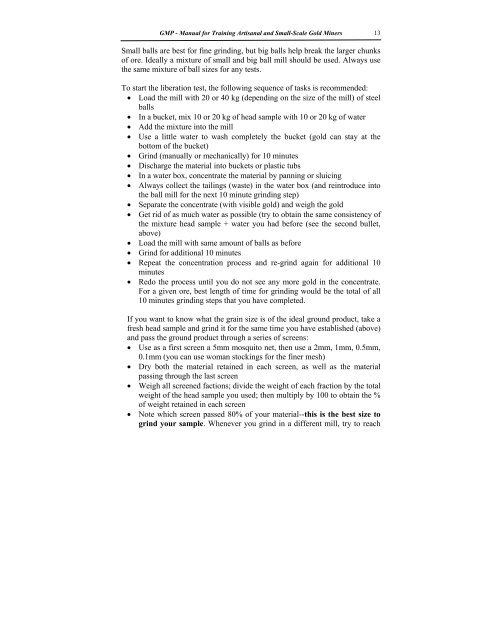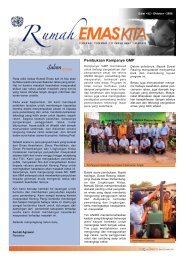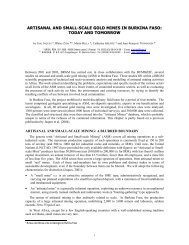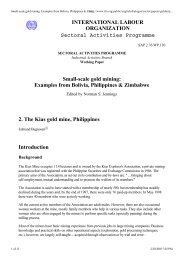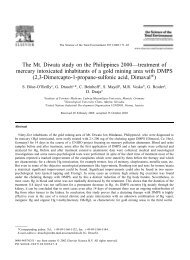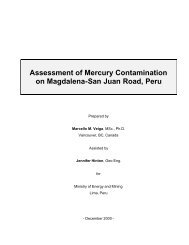Manual for Training Artisanal and Small-Scale Gold Miners
Manual for Training Artisanal and Small-Scale Gold Miners
Manual for Training Artisanal and Small-Scale Gold Miners
You also want an ePaper? Increase the reach of your titles
YUMPU automatically turns print PDFs into web optimized ePapers that Google loves.
GMP - <strong>Manual</strong> <strong>for</strong> <strong>Training</strong> <strong>Artisanal</strong> <strong>and</strong> <strong>Small</strong>-<strong>Scale</strong> <strong>Gold</strong> <strong>Miners</strong><br />
<strong>Small</strong> balls are best <strong>for</strong> fine grinding, but big balls help break the larger chunks<br />
of ore. Ideally a mixture of small <strong>and</strong> big ball mill should be used. Always use<br />
the same mixture of ball sizes <strong>for</strong> any tests.<br />
To start the liberation test, the following sequence of tasks is recommended:<br />
• Load the mill with 20 or 40 kg (depending on the size of the mill) of steel<br />
balls<br />
• In a bucket, mix 10 or 20 kg of head sample with 10 or 20 kg of water<br />
• Add the mixture into the mill<br />
• Use a little water to wash completely the bucket (gold can stay at the<br />
bottom of the bucket)<br />
• Grind (manually or mechanically) <strong>for</strong> 10 minutes<br />
• Discharge the material into buckets or plastic tubs<br />
• In a water box, concentrate the material by panning or sluicing<br />
• Always collect the tailings (waste) in the water box (<strong>and</strong> reintroduce into<br />
the ball mill <strong>for</strong> the next 10 minute grinding step)<br />
• Separate the concentrate (with visible gold) <strong>and</strong> weigh the gold<br />
• Get rid of as much water as possible (try to obtain the same consistency of<br />
the mixture head sample + water you had be<strong>for</strong>e (see the second bullet,<br />
above)<br />
• Load the mill with same amount of balls as be<strong>for</strong>e<br />
• Grind <strong>for</strong> additional 10 minutes<br />
• Repeat the concentration process <strong>and</strong> re-grind again <strong>for</strong> additional 10<br />
minutes<br />
• Redo the process until you do not see any more gold in the concentrate.<br />
For a given ore, best length of time <strong>for</strong> grinding would be the total of all<br />
10 minutes grinding steps that you have completed.<br />
If you want to know what the grain size is of the ideal ground product, take a<br />
fresh head sample <strong>and</strong> grind it <strong>for</strong> the same time you have established (above)<br />
<strong>and</strong> pass the ground product through a series of screens:<br />
• Use as a first screen a 5mm mosquito net, then use a 2mm, 1mm, 0.5mm,<br />
0.1mm (you can use woman stockings <strong>for</strong> the finer mesh)<br />
• Dry both the material retained in each screen, as well as the material<br />
passing through the last screen<br />
• Weigh all screened factions; divide the weight of each fraction by the total<br />
weight of the head sample you used; then multiply by 100 to obtain the %<br />
of weight retained in each screen<br />
• Note which screen passed 80% of your material--this is the best size to<br />
grind your sample. Whenever you grind in a different mill, try to reach<br />
13


